人教版高中英语必修四 Unit 1 Women of achievement Grammar (主谓一致)课件(共48张)
文档属性
| 名称 | 人教版高中英语必修四 Unit 1 Women of achievement Grammar (主谓一致)课件(共48张) |  | |
| 格式 | zip | ||
| 文件大小 | 431.1KB | ||
| 资源类型 | 教案 | ||
| 版本资源 | 人教版(新课程标准) | ||
| 科目 | 英语 | ||
| 更新时间 | 2019-04-14 21:51:49 | ||
图片预览


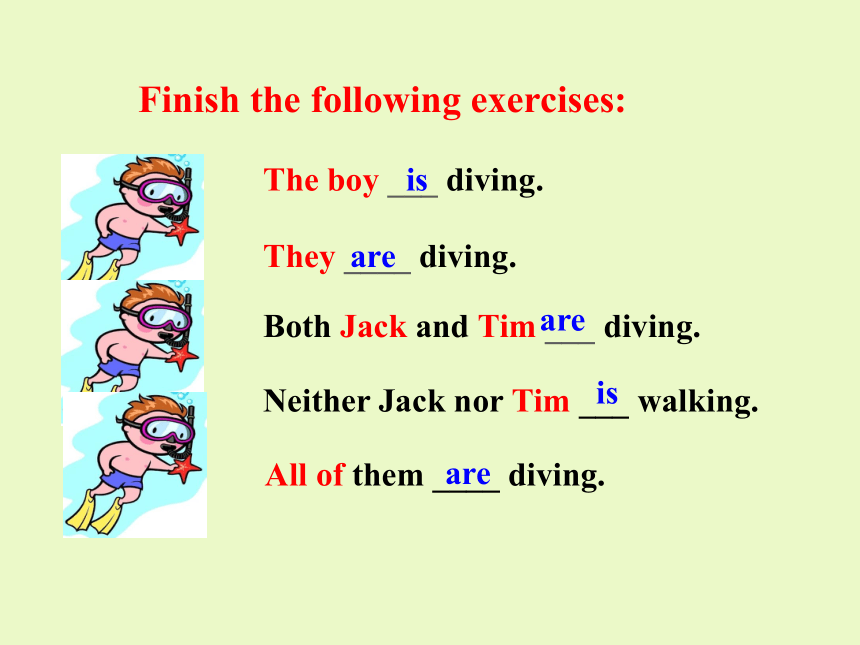
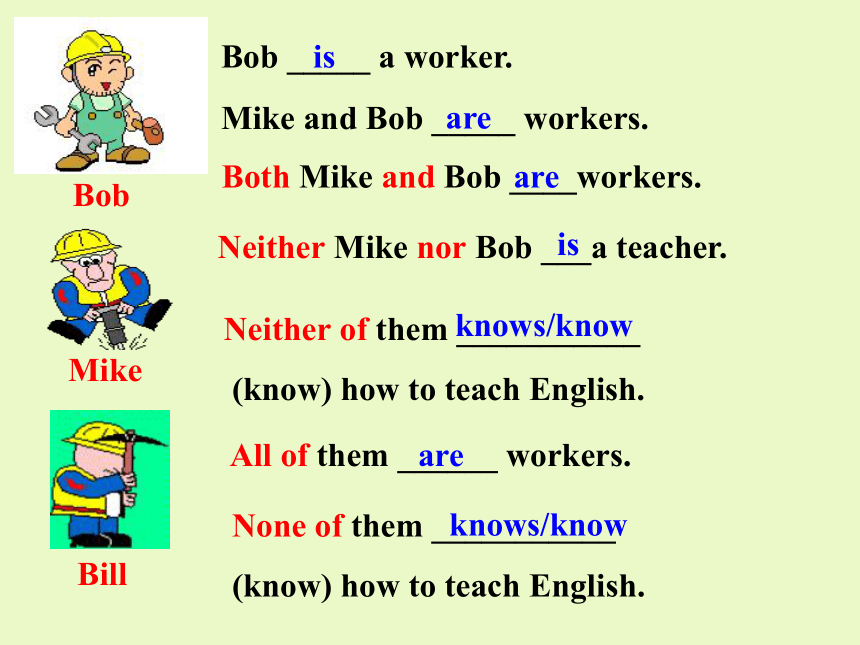


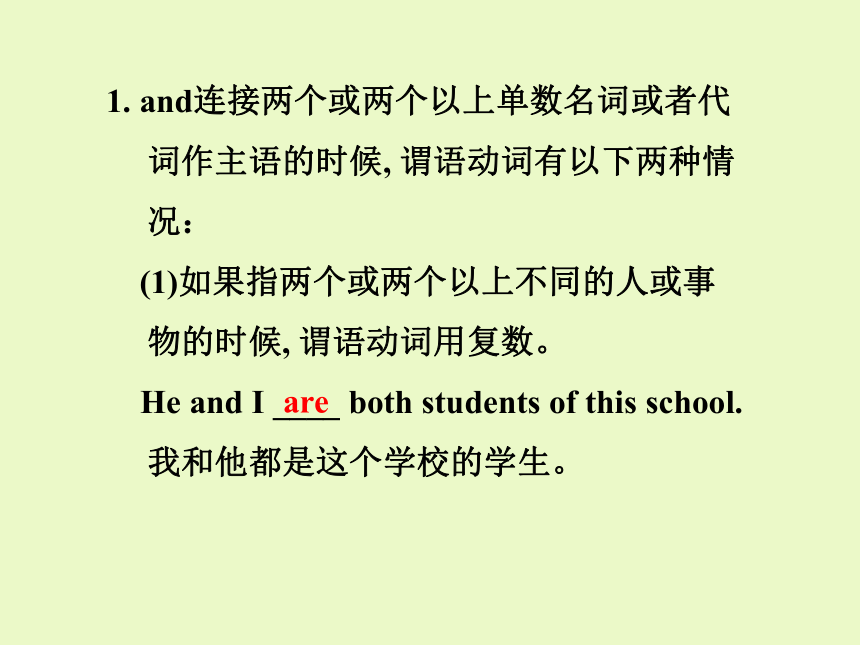
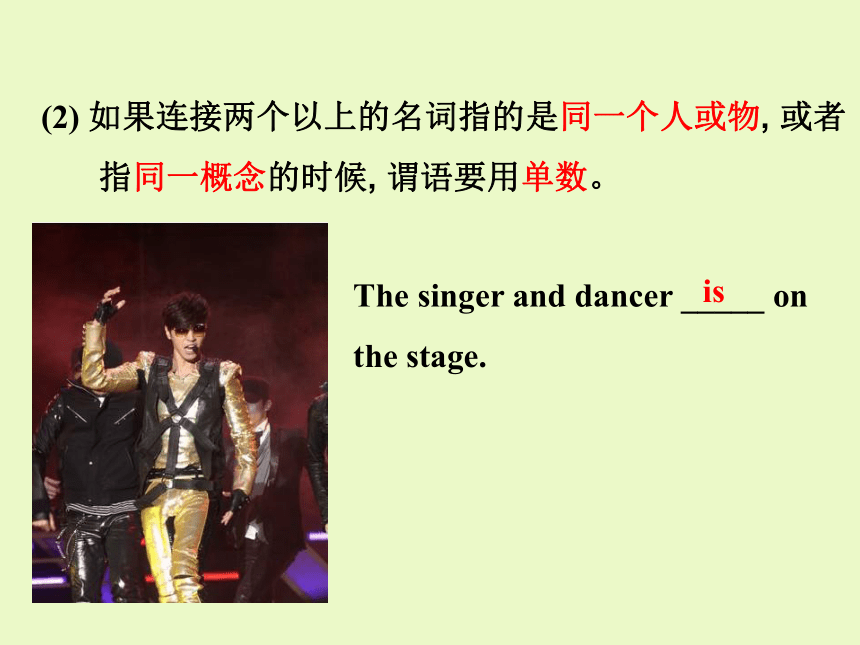
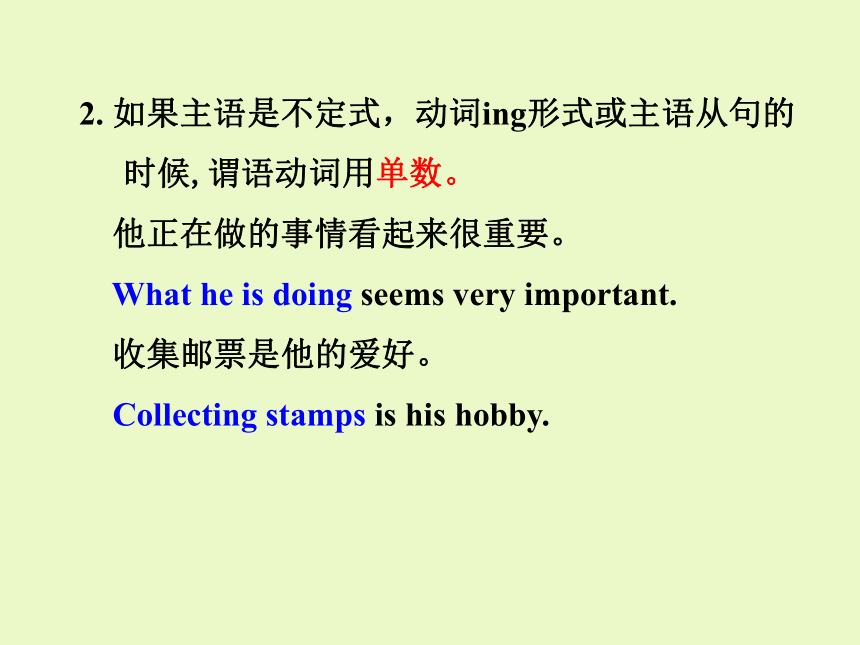
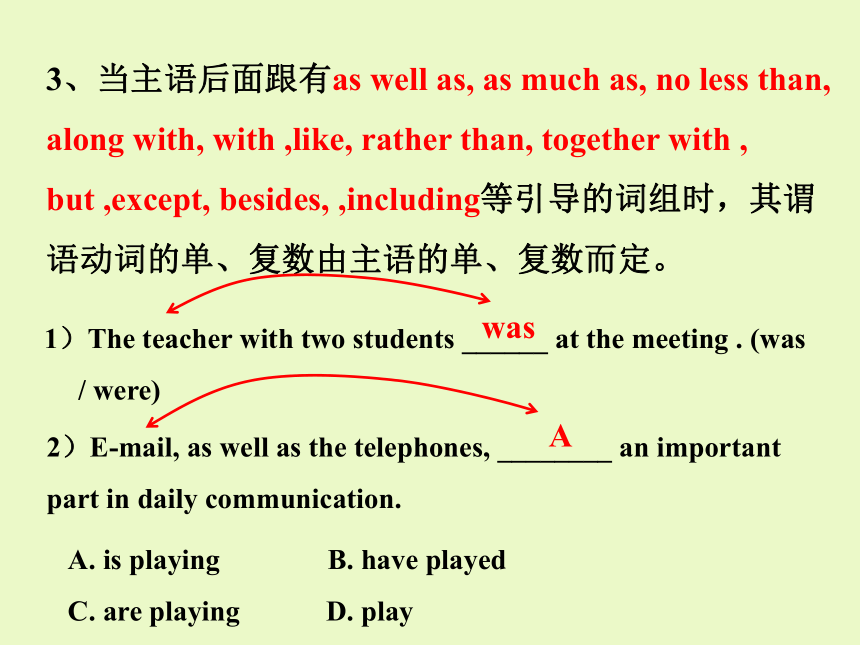

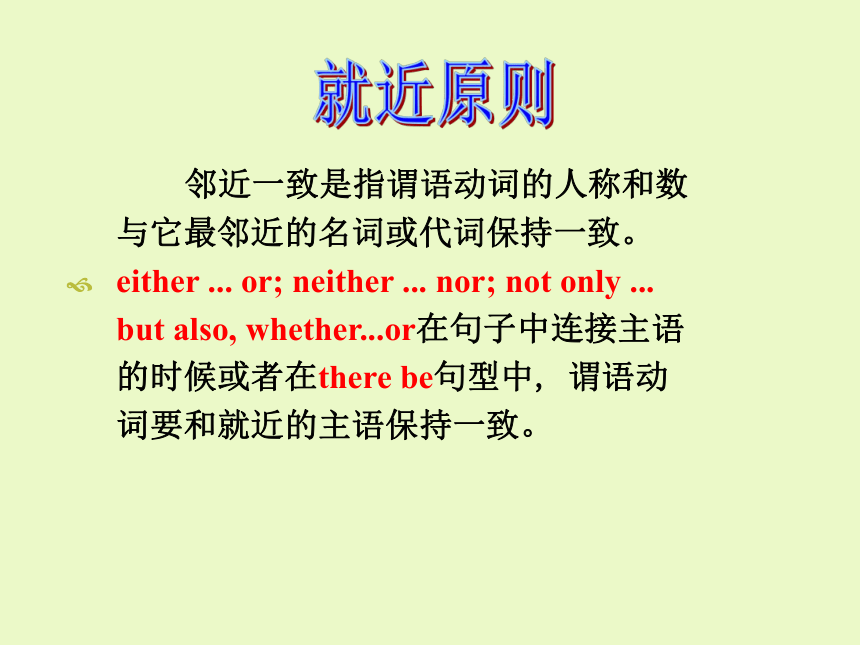
文档简介
课件48张PPT。Unit1 Women of achievement
主谓一致 Subject-Verb AgreementThe boy ___ diving.They ____ diving.Both Jack and Tim ___ diving.All of them ____ diving.Neither Jack nor Tim ___ walking.isareareisareFinish the following exercises:Bob Bob _____ a worker.isMike Mike and Bob _____ workers.areBoth Mike and Bob ____workers.areNeither Mike nor Bob ___a teacher.isBill Neither of them ___________
(know) how to teach English. knows/knowAll of them ______ workers.None of them ___________
(know) how to teach English.are knows/know主谓一致的定义
英语句子中,主语的“人称”和“数”要限制、决定谓语动词的形式变化,这就叫“主谓一致”关系。它通常依据三项原则: 1)语法一致;2)意义一致;3)就近一致主谓一致主要有以下几种情况: 语法一致是指句子的主语和谓语在语法形式上一致,即谓语动词的单复数形式依主语的单复数形式而定。主语为单数时谓语动词用单数,主语为复数时谓语动词也用复数。语法一致原则1. and连接两个或两个以上单数名词或者代词作主语的时候, 谓语动词有以下两种情况:
(1)如果指两个或两个以上不同的人或事物的时候, 谓语动词用复数。
He and I ____ both students of this school. 我和他都是这个学校的学生。 areThe singer and dancer _____ on the stage.is(2) 如果连接两个以上的名词指的是同一个人或物, 或者指同一概念的时候, 谓语要用单数。 2. 如果主语是不定式,动词ing形式或主语从句的时候,谓语动词用单数。
他正在做的事情看起来很重要。
What he is doing seems very important.
收集邮票是他的爱好。
Collecting stamps is his hobby. 3、当主语后面跟有as well as, as much as, no less than, along with, with ,like, rather than, together with , but ,except, besides, ,including等引导的词组时,其谓语动词的单、复数由主语的单、复数而定。1)The teacher with two students ______ at the meeting . (was / were)
was2)E-mail, as well as the telephones, ________ an important
part in daily communication.A. is playing B. have played
C. are playing D. play A4. 用连接的并列主语被each, every, no或 many a 修饰时,谓语动词 用单数。
Every desk and every chair is made of wood.
Many a boy and (many a ) girl has made the same mistake. 邻近一致是指谓语动词的人称和数与它最邻近的名词或代词保持一致。
either ... or; neither ... nor; not only ... but also, whether...or在句子中连接主语的时候或者在there be句型中, 谓语动词要和就近的主语保持一致。就近原则 Not only the students but also the teacher wishes for a holiday. Neither you nor I am wrong.
There is a cup of tea and some apples
on the table. 所谓概念一致原则是指谓语动词和主语一致不是取决于主语的语法形式, 而是其实际意义。有的主语名词在形式上是单数, 但在意义上却是复数;有的主语名词在形式上是复数, 但在意义上却是单数。概念一致原则1. 不定代词all, more, some, any, none作主语, 谓语动词视情况而定。All of the apples ____ rotten.
所有的苹果都烂了。
All of the apple ____ rotten.
整个苹果都烂了。
不定代词all, more, some, any, none作主语, 谓语动词视情况而定。 are isNone of the money _____ left.
没有剩下一点钱。
None of the students _____ there.
没有学生在那里。 is is2. the rest of; half of; part of; majority of; percent of; one third of 在句子中加名词作主语的时候, 谓语动词与of 后面的名词保持一致。Half of the students _____ finished their
composition.
一半的学生已经完成了他们的作文。
Half of the apple ____ bad.
一半的苹果坏了。
About 60 percent of the students in our
school ____ boys.
我们学校, 大约百分之六十的学生是男
生。haveisare3. 集合名词作主语, 动词可用单数, 也可以用复数。主要由句子的意思决定。强调整体谓语动词用单数;指全体人员时, 动词则用复数。这一类常见的集合名词有public, family, class, crowd, population, team, group。His family ____ going out.
他们全家要外出。
His family ____ all music lovers.
他们全家人都是音乐爱好者。
集合名词作主语, 动词可用单数, 也可以用复数。主要由句子的意思决定。强调整体谓语动词用单数;指全体人员时, 动词则用复数。这一类常见的集合名词有public, family, class, crowd, population, team, group。is are 4. 某些名词如people, police, cattle等, 形式上是单数, 但意义上是复数, 谓语动词应用复数。people指“民族”时是例外。
The police are searching for a thief.
The cattle are eating grass on the hill.5. 复合不定代词作主语, 谓语动词要用单数,如someone, somebody, something, anybody, anyone, anything, everybody, everyone, everything, nobody, no one, nothing。
Someone is asking for you.
有人找你。
Nothing is found in the room.
在屋子里什么也没找到。6. 某些名词如clothes, trousers, shoes, glasses等, 通常只用其复数形式, 但当它们被a pair of 修饰时, 谓语动词用单数。如:
The pair of shoes is worn out.
这双鞋破了。
The shoes are worn out.
鞋子破了。某些名词以s结尾如maths, politics, physics, news, plastics等, 谓语动词应用单数。
Physics is a very interesting subject. 物理是一门很有趣的学科。 8. every... and every ...; each ... and each ...; no ... and no ... 在以上短语中and连接的单数名词, 整个短语在句中作主语时, 谓语动词常使用单数。
Each man and each woman is asked to attend. Every boy and every girl in the class is diligent. 班级中的每个男孩女孩都很用功。
No sound and no voice is heard.
听不到任何声音。9. 以a number of作主语时, 谓语动词用复数; 以the number of 作主语时, 谓语动词用单数。
A number of new books are on the desk.
The number of students in you class is 50.10. 有些名词的单数和复数形式一样, 作主语的时候, 其谓语动词由上下文决定, 这一类名词有: means, works, deer, fish, sheep, Chinese, Japanese等。
Not every means is useful.
不是每种方法都好使。
Not all means are useful.
不是所有的方法都好使。 11. many a, more than one, one and a half与单数名词组成的短语, 谓语用单数。
Many a boy has seen it. 许多孩子都看到了。
12. 书刊名、时间、距离、价格、度量衡等的复数名词作主语时, 谓语动词常用单数。
Thirty years is not a long time.
Roots is a famous American novel.1. this kind of book = a book of this kind (这种书) , 其谓语用单数; 短语this kind of men = men of this kind = these kind of men (口语) (这一类人), 但this kind of men 的谓语用单数, men of this kind 和these kind of men 的谓语用复数, all kinds of 后跟复数名词, 谓语用复数形式。例如:应该注意的几个问题: This kind of men is dangerous.
Men of this kind are dangerous.
2. 在主谓倒装的句子中, 谓语动词的数应与其后的主语一致。例如:
Between the two windows hangs a picture.3. “分数或百分数+名词”构成的短语以及由“ a lot of, lots of, plenty of, a large quantity of, a heap of, heaps of, half of + 名词”构成的短语作主语时,其谓语动词要与短语中of 后面的名词的数保持一致, 这是因为短语中后面的名词是中心词, 而短语中前面的量词是修饰语。例如:Lots of damage was caused by fire.
About three-fourths of the earth’s surface is covered with water.
Three-fifths of the workers here are women.
和这种情况类似的还有“a number of + 名词复数”。但是,“the number of + 名词”的中心词却是number。试比较:A number of students have gone to the countryside to help with the autumn harvest.
The number of pages in this book is two hundred.注意:
a (large) quantity of 修饰可数或不可数名词, 其短语作主语时, 谓语动词用单数。
A large quantity of people is needed here.quantities of 修饰可数或不可数名词, 其短语作主语时, 谓语动词一般用复数。例如:
Quantities of food (nuts) were on the table.
短语in quantity, in large quantities 意为 “大量”; in small quantities 意为“少量”。 4. a great deal of, a large amount of, 修饰不可数名词, 其短语作主语时, 谓语动词通常用单数; large amounts of 修饰不可数名词, 其短语作主语时, 谓语动词通常用复数。例如:A large amount of (A great deal of ) damage was done in a very short time.
Large amounts of money were spent on the bridge.5. 表示数量的one and a half 后, 名词要用复数形式, 但是其短语作主语时, 谓语动词用单数形式。例如:
One and a half bananas is left on the table.6. 如果主语由“the + 形容词(或过去分词)”结构担任时, 谓语通常用复数;这类词有: the brave, the poor, the rich, the blind, the young, the old, the sick, the dead, the deaf and dub, the oppressed, the injured, the wounded, the unemployed 等; 但也有少数的过去分词与定冠词连用时指个别,则用单数。例如:The blind study in special school.
The departed (死者) was a well-known engineer.
这类形容词或分词如果要表示个体时,就要与名词man, person或表示人的单数连用。例如: an old man, a rich person, the (a) wounded soldier.1. One third of the country _____ covered with trees and the majority of the citizens _____ black people.
A. is; are B. is; is
C. are; are D. are; is Pratice2. The factory used 65 percent of the raw materials, the rest of which _____ saved for other purposes.
A. is B. are
C. was D. were3. Such poets as Shakespeare _____ widely read, of whose works, however, some _____ difficult to understand.
A. are; are B. is; is
C. are; is D. is; are4. Listening to loud music at rock concerts _____ caused hearing loss in some teenagers. (湖南2010)
A. is B. are C. has D. have 5. —Is everyone here?
—Not yet ... Look, there _____ the rest
of our guests!
A. come B. comes
C. is coming D. are coming
6. Barbara is easy to recognize as she’s the only one of the women who _____ evening dress.
A. wear B. wears
C. has worn D. have wornHomeworkFinish the exercises in USING STRUCTURES on Page 43.
主谓一致 Subject-Verb AgreementThe boy ___ diving.They ____ diving.Both Jack and Tim ___ diving.All of them ____ diving.Neither Jack nor Tim ___ walking.isareareisareFinish the following exercises:Bob Bob _____ a worker.isMike Mike and Bob _____ workers.areBoth Mike and Bob ____workers.areNeither Mike nor Bob ___a teacher.isBill Neither of them ___________
(know) how to teach English. knows/knowAll of them ______ workers.None of them ___________
(know) how to teach English.are knows/know主谓一致的定义
英语句子中,主语的“人称”和“数”要限制、决定谓语动词的形式变化,这就叫“主谓一致”关系。它通常依据三项原则: 1)语法一致;2)意义一致;3)就近一致主谓一致主要有以下几种情况: 语法一致是指句子的主语和谓语在语法形式上一致,即谓语动词的单复数形式依主语的单复数形式而定。主语为单数时谓语动词用单数,主语为复数时谓语动词也用复数。语法一致原则1. and连接两个或两个以上单数名词或者代词作主语的时候, 谓语动词有以下两种情况:
(1)如果指两个或两个以上不同的人或事物的时候, 谓语动词用复数。
He and I ____ both students of this school. 我和他都是这个学校的学生。 areThe singer and dancer _____ on the stage.is(2) 如果连接两个以上的名词指的是同一个人或物, 或者指同一概念的时候, 谓语要用单数。 2. 如果主语是不定式,动词ing形式或主语从句的时候,谓语动词用单数。
他正在做的事情看起来很重要。
What he is doing seems very important.
收集邮票是他的爱好。
Collecting stamps is his hobby. 3、当主语后面跟有as well as, as much as, no less than, along with, with ,like, rather than, together with , but ,except, besides, ,including等引导的词组时,其谓语动词的单、复数由主语的单、复数而定。1)The teacher with two students ______ at the meeting . (was / were)
was2)E-mail, as well as the telephones, ________ an important
part in daily communication.A. is playing B. have played
C. are playing D. play A4. 用连接的并列主语被each, every, no或 many a 修饰时,谓语动词 用单数。
Every desk and every chair is made of wood.
Many a boy and (many a ) girl has made the same mistake. 邻近一致是指谓语动词的人称和数与它最邻近的名词或代词保持一致。
either ... or; neither ... nor; not only ... but also, whether...or在句子中连接主语的时候或者在there be句型中, 谓语动词要和就近的主语保持一致。就近原则 Not only the students but also the teacher wishes for a holiday. Neither you nor I am wrong.
There is a cup of tea and some apples
on the table. 所谓概念一致原则是指谓语动词和主语一致不是取决于主语的语法形式, 而是其实际意义。有的主语名词在形式上是单数, 但在意义上却是复数;有的主语名词在形式上是复数, 但在意义上却是单数。概念一致原则1. 不定代词all, more, some, any, none作主语, 谓语动词视情况而定。All of the apples ____ rotten.
所有的苹果都烂了。
All of the apple ____ rotten.
整个苹果都烂了。
不定代词all, more, some, any, none作主语, 谓语动词视情况而定。 are isNone of the money _____ left.
没有剩下一点钱。
None of the students _____ there.
没有学生在那里。 is is2. the rest of; half of; part of; majority of; percent of; one third of 在句子中加名词作主语的时候, 谓语动词与of 后面的名词保持一致。Half of the students _____ finished their
composition.
一半的学生已经完成了他们的作文。
Half of the apple ____ bad.
一半的苹果坏了。
About 60 percent of the students in our
school ____ boys.
我们学校, 大约百分之六十的学生是男
生。haveisare3. 集合名词作主语, 动词可用单数, 也可以用复数。主要由句子的意思决定。强调整体谓语动词用单数;指全体人员时, 动词则用复数。这一类常见的集合名词有public, family, class, crowd, population, team, group。His family ____ going out.
他们全家要外出。
His family ____ all music lovers.
他们全家人都是音乐爱好者。
集合名词作主语, 动词可用单数, 也可以用复数。主要由句子的意思决定。强调整体谓语动词用单数;指全体人员时, 动词则用复数。这一类常见的集合名词有public, family, class, crowd, population, team, group。is are 4. 某些名词如people, police, cattle等, 形式上是单数, 但意义上是复数, 谓语动词应用复数。people指“民族”时是例外。
The police are searching for a thief.
The cattle are eating grass on the hill.5. 复合不定代词作主语, 谓语动词要用单数,如someone, somebody, something, anybody, anyone, anything, everybody, everyone, everything, nobody, no one, nothing。
Someone is asking for you.
有人找你。
Nothing is found in the room.
在屋子里什么也没找到。6. 某些名词如clothes, trousers, shoes, glasses等, 通常只用其复数形式, 但当它们被a pair of 修饰时, 谓语动词用单数。如:
The pair of shoes is worn out.
这双鞋破了。
The shoes are worn out.
鞋子破了。某些名词以s结尾如maths, politics, physics, news, plastics等, 谓语动词应用单数。
Physics is a very interesting subject. 物理是一门很有趣的学科。 8. every... and every ...; each ... and each ...; no ... and no ... 在以上短语中and连接的单数名词, 整个短语在句中作主语时, 谓语动词常使用单数。
Each man and each woman is asked to attend. Every boy and every girl in the class is diligent. 班级中的每个男孩女孩都很用功。
No sound and no voice is heard.
听不到任何声音。9. 以a number of作主语时, 谓语动词用复数; 以the number of 作主语时, 谓语动词用单数。
A number of new books are on the desk.
The number of students in you class is 50.10. 有些名词的单数和复数形式一样, 作主语的时候, 其谓语动词由上下文决定, 这一类名词有: means, works, deer, fish, sheep, Chinese, Japanese等。
Not every means is useful.
不是每种方法都好使。
Not all means are useful.
不是所有的方法都好使。 11. many a, more than one, one and a half与单数名词组成的短语, 谓语用单数。
Many a boy has seen it. 许多孩子都看到了。
12. 书刊名、时间、距离、价格、度量衡等的复数名词作主语时, 谓语动词常用单数。
Thirty years is not a long time.
Roots is a famous American novel.1. this kind of book = a book of this kind (这种书) , 其谓语用单数; 短语this kind of men = men of this kind = these kind of men (口语) (这一类人), 但this kind of men 的谓语用单数, men of this kind 和these kind of men 的谓语用复数, all kinds of 后跟复数名词, 谓语用复数形式。例如:应该注意的几个问题: This kind of men is dangerous.
Men of this kind are dangerous.
2. 在主谓倒装的句子中, 谓语动词的数应与其后的主语一致。例如:
Between the two windows hangs a picture.3. “分数或百分数+名词”构成的短语以及由“ a lot of, lots of, plenty of, a large quantity of, a heap of, heaps of, half of + 名词”构成的短语作主语时,其谓语动词要与短语中of 后面的名词的数保持一致, 这是因为短语中后面的名词是中心词, 而短语中前面的量词是修饰语。例如:Lots of damage was caused by fire.
About three-fourths of the earth’s surface is covered with water.
Three-fifths of the workers here are women.
和这种情况类似的还有“a number of + 名词复数”。但是,“the number of + 名词”的中心词却是number。试比较:A number of students have gone to the countryside to help with the autumn harvest.
The number of pages in this book is two hundred.注意:
a (large) quantity of 修饰可数或不可数名词, 其短语作主语时, 谓语动词用单数。
A large quantity of people is needed here.quantities of 修饰可数或不可数名词, 其短语作主语时, 谓语动词一般用复数。例如:
Quantities of food (nuts) were on the table.
短语in quantity, in large quantities 意为 “大量”; in small quantities 意为“少量”。 4. a great deal of, a large amount of, 修饰不可数名词, 其短语作主语时, 谓语动词通常用单数; large amounts of 修饰不可数名词, 其短语作主语时, 谓语动词通常用复数。例如:A large amount of (A great deal of ) damage was done in a very short time.
Large amounts of money were spent on the bridge.5. 表示数量的one and a half 后, 名词要用复数形式, 但是其短语作主语时, 谓语动词用单数形式。例如:
One and a half bananas is left on the table.6. 如果主语由“the + 形容词(或过去分词)”结构担任时, 谓语通常用复数;这类词有: the brave, the poor, the rich, the blind, the young, the old, the sick, the dead, the deaf and dub, the oppressed, the injured, the wounded, the unemployed 等; 但也有少数的过去分词与定冠词连用时指个别,则用单数。例如:The blind study in special school.
The departed (死者) was a well-known engineer.
这类形容词或分词如果要表示个体时,就要与名词man, person或表示人的单数连用。例如: an old man, a rich person, the (a) wounded soldier.1. One third of the country _____ covered with trees and the majority of the citizens _____ black people.
A. is; are B. is; is
C. are; are D. are; is Pratice2. The factory used 65 percent of the raw materials, the rest of which _____ saved for other purposes.
A. is B. are
C. was D. were3. Such poets as Shakespeare _____ widely read, of whose works, however, some _____ difficult to understand.
A. are; are B. is; is
C. are; is D. is; are4. Listening to loud music at rock concerts _____ caused hearing loss in some teenagers. (湖南2010)
A. is B. are C. has D. have 5. —Is everyone here?
—Not yet ... Look, there _____ the rest
of our guests!
A. come B. comes
C. is coming D. are coming
6. Barbara is easy to recognize as she’s the only one of the women who _____ evening dress.
A. wear B. wears
C. has worn D. have wornHomeworkFinish the exercises in USING STRUCTURES on Page 43.
同课章节目录
